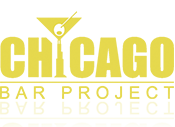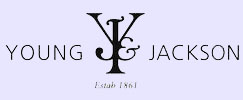
Melbourne, 3000
+61 (03) 9650 3884
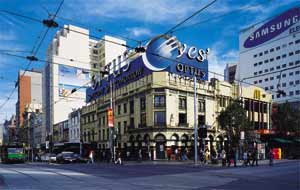 Since 1861, Young & Jackson’s, or the “Y&J” as it is known to Melbournians, has been an institution. Located in the heart of Melbourne, at the intersection of Flinders and Swanston Streets, the Y&J is where Melbourne drinkers have congregated for almost 150 years.
Since 1861, Young & Jackson’s, or the “Y&J” as it is known to Melbournians, has been an institution. Located in the heart of Melbourne, at the intersection of Flinders and Swanston Streets, the Y&J is where Melbourne drinkers have congregated for almost 150 years.
Accessible by car, tram, train or water taxi, Young and Jackson’s is simply a magnificent place to watch the hustle and bustle of the inner city of Melbourne. Opposite Flinders Street Station, the nearly completed Federation Square and St Patrick’s Cathedral, Y&J offers some of the most brilliant views any pub can boast about. This is particularly true at sunset, when Flinders Street Station’s nineteenth century architecture is lit up! Y&J’s itself is worth the visit just for its old style pub architecture. The split level design offers patrons two levels and, unfortunately, I have only had the pleasure of drinking in the brasserie, located on the ground level, opposite the dance floor (remember the dance shoes), and it can be entered by the main doors on Swanston Street.
The interior of Y&J’s was refurbished and remodelled in the late 1990s, like so many other Melbourne pubs in the CBD (central business district or “downtown” in American terms). Fortunately for its patrons, the renovations have returned the ambience of yesteryear to Young and Jackson’s. Previously, it was verging on the level of dive bars.
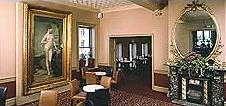 Stain glass windows sit above the main entrance (there are four entrances/exits, plus a bottle shop), combined with intricate plaster ceilings and modern wooden bars, making Young and Jackson’s very unique. Mix in with this a blend of jazz, funk and trendy background music, and you have a very relaxing atmosphere, that according to Mad Dog is a “good starting bar.”
Stain glass windows sit above the main entrance (there are four entrances/exits, plus a bottle shop), combined with intricate plaster ceilings and modern wooden bars, making Young and Jackson’s very unique. Mix in with this a blend of jazz, funk and trendy background music, and you have a very relaxing atmosphere, that according to Mad Dog is a “good starting bar.”
Before I launch into the excellent food, beer and wine menus, I must mention one aspect of Y&J’s that is famous Australia-wide – Chloe! Don’t get excited, Chloe is not the pub’s prostitute, nor is she a topless barmaid, although she is naked. Chloe is one of Australia’s most famous portraits, having been painted around the time the pub opened. Since her first public appearance, Chloe has been controversial to say the least. The fiery red head is completely naked, from head to toe and one can only imagine the sensation she caused when she first graced the walls of Young and Jackson’s. Nowadays people gather to see what all the fuss is about.
To the pub’s main bar-the brasserie. As mentioned its stained wooden panels are quite different and creates a relaxed feeling. There are newspapers and magazines that patrons can peruse, both on the bar and behind it. There are also old style CUB (Carlton and United Breweries) kegs, adding a charm to the entire bar.
 As for the wine menu I have no idea about what constitutes a good wine, or a bad wine. There was however an extensive menu that looked appealing.
As for the wine menu I have no idea about what constitutes a good wine, or a bad wine. There was however an extensive menu that looked appealing.
However, the beer menu is a different story. The standard brews such as Carlton Draught and Stella Artois are available. Thankfully it is not a Toohey’s pub. Lion Nathan, the owners of Toohey’s purchased over fifty Melbourne bars in an effort to increase the popularity of Toohey’s, and break the strangle hold VB has over the beer market in Australia, particularly in Melbourne. Hence not a drop of Toohey’s can be seen, smelt or consumed.
 For me the micro beers add a nice spice to the common tap beers located throughout Australian pubs. Although I did not taste them, Y&J’s naked ale (in honour of the charming Chloe) and the Red Bluff Ale (winner of Y&J’s micro brewery competition) provide the beer connoisseur with rarely seen beers. A beer from Carlton’s stock I had never seen, but was greatly impressed by was Carlton Black. A strong taste, with some bitterness goes down better after each sip. While drinking my black ale I ate a fruit platter, then dipped the various fruits in yoghurt. The results were stunning! After each sip my palate was cleansed, and I could taste the full array of the beer’s flavours. Try it next time you are drinking a dark malted beer. Let’s hope Carlton Black hits CUB’s marketing department and it floods the bottle shops and boozeries.
For me the micro beers add a nice spice to the common tap beers located throughout Australian pubs. Although I did not taste them, Y&J’s naked ale (in honour of the charming Chloe) and the Red Bluff Ale (winner of Y&J’s micro brewery competition) provide the beer connoisseur with rarely seen beers. A beer from Carlton’s stock I had never seen, but was greatly impressed by was Carlton Black. A strong taste, with some bitterness goes down better after each sip. While drinking my black ale I ate a fruit platter, then dipped the various fruits in yoghurt. The results were stunning! After each sip my palate was cleansed, and I could taste the full array of the beer’s flavours. Try it next time you are drinking a dark malted beer. Let’s hope Carlton Black hits CUB’s marketing department and it floods the bottle shops and boozeries.
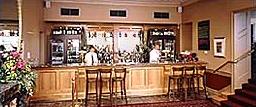 Aside from my fruit platter, two friends had the Scotch Fillet Burger. A huge tender Scotch fillet on a focaccia bun with rocket lettuce and the usual fillings. Plus fries and all you pay is a meagre $13.50. As Commie stated, “It’s good eating!”
Aside from my fruit platter, two friends had the Scotch Fillet Burger. A huge tender Scotch fillet on a focaccia bun with rocket lettuce and the usual fillings. Plus fries and all you pay is a meagre $13.50. As Commie stated, “It’s good eating!”
The cheese platter caught my eye on the menu. It includes brie, blue cheddar, crackers, dried fruit and nuts. I will definitely try it next time I pass through.
From 7am to 11am, Monday through Friday, and 8am to 11am on weekends, there is a great breakfast menu available. It has the usual array of fried breakfast foods, plus for those of you still struggling with the effects of the previous night, a Bloody Mary for $8 should ease some of the pain (or just open a can of worms, so to speak).
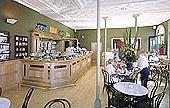 If there is a down side to Y&J’s it is the security staff, or bouncers. These guys can be rude, difficult and outright annoying simply because they have the “power.” Don’t let them ruin your night though.
If there is a down side to Y&J’s it is the security staff, or bouncers. These guys can be rude, difficult and outright annoying simply because they have the “power.” Don’t let them ruin your night though.
Well, there you have it, my first bar review for the Chicago/Melbourne bar project. Traditionally, my mates and I begin a night in Melbourne at Young & Jackson’s. The people, its atmosphere, history, and let’s not forget Chloe all provide incentives to visit, and to become a regular. I hope you take the time to visit Y&J’s when next in Melbourne, as it is a truly unique Aussie pub, and part of Melbourne’s heritage.
A Brief History of Young & Jackson’s
 Our story begins in the year 1837, when Melbourne was an outpost of less than 200 people. At this time, one of Melbourne’s founding fathers, John Batman, purchased the original block of land now occupied by Young & Jackson’s for a mere €100 as part of Melbourne’s first land sale. The home standing on the plot was converted into the city’s first schoolhouse, and was then razed in 1853 to make way for five bluestone buildings to be occupied by various businesses and James Graham’s corner butcher shop. All had sprung up following the Gold Rush in Victoria’s countryside, and the influx of over 10,000 inhabitants in Melbourne’s first decade as a city. In the early 1860’s, Melbourne’s population had swelled to 500,000 people and Graham’s butcher shop, in prime location, moved out and the building became the Princes Bridge Hotel on July 1, 1861. Earlier that year, the Argus newspaper observed that, “The style of the fittings shows that it would be nothing more than a low bar, of which we have too many already. Stale beer, tobacco and choice language, would then be the first greeting many thousands would receive on coming into town in the morning.” That was just the right formula for the hotel bar to thrive over the next 14 years, when it was then licensed to two neuvo-riche Irishmen named Henry Figsby Young and Thomas Joshua Jackson upon their successful return from the gold fields in New Zealand in 1875. For the next 15 years, the two enterprising lads both looked after the place well. Numerous improvements were made to the hotel, including the joining of all five separate buildings into what is today the same building that houses the Young & Jackson Hotel. While the partnership dissolved around 1890, the inn continuing on as the Young & Jackson Hotel and Henry Young himself carried on as publican until 1914. In addition to the hotel bearing his name, Henry Young’s legacy lives on today because of his acquisition of a painting that has a more colourful and adventurous history than Young or Jackson themselves.
Our story begins in the year 1837, when Melbourne was an outpost of less than 200 people. At this time, one of Melbourne’s founding fathers, John Batman, purchased the original block of land now occupied by Young & Jackson’s for a mere €100 as part of Melbourne’s first land sale. The home standing on the plot was converted into the city’s first schoolhouse, and was then razed in 1853 to make way for five bluestone buildings to be occupied by various businesses and James Graham’s corner butcher shop. All had sprung up following the Gold Rush in Victoria’s countryside, and the influx of over 10,000 inhabitants in Melbourne’s first decade as a city. In the early 1860’s, Melbourne’s population had swelled to 500,000 people and Graham’s butcher shop, in prime location, moved out and the building became the Princes Bridge Hotel on July 1, 1861. Earlier that year, the Argus newspaper observed that, “The style of the fittings shows that it would be nothing more than a low bar, of which we have too many already. Stale beer, tobacco and choice language, would then be the first greeting many thousands would receive on coming into town in the morning.” That was just the right formula for the hotel bar to thrive over the next 14 years, when it was then licensed to two neuvo-riche Irishmen named Henry Figsby Young and Thomas Joshua Jackson upon their successful return from the gold fields in New Zealand in 1875. For the next 15 years, the two enterprising lads both looked after the place well. Numerous improvements were made to the hotel, including the joining of all five separate buildings into what is today the same building that houses the Young & Jackson Hotel. While the partnership dissolved around 1890, the inn continuing on as the Young & Jackson Hotel and Henry Young himself carried on as publican until 1914. In addition to the hotel bearing his name, Henry Young’s legacy lives on today because of his acquisition of a painting that has a more colourful and adventurous history than Young or Jackson themselves.
Melbourne’s rapid growth in the first 11 years was due to the gold rush in surrounding areas. An outpost of 180 people in 1836, grew to a town of 10,000 in 1842 and was proclaimed a city in 1847. The Batman site’s central location and proximity to the Yarra River docks made the land economically valuable. In 1853 the old schoolhouse was razed, the land subdivided and five bluestone warehouses erected on the future Y&J’s site housing various merchants, lawyers, and the butcher James Graham in the corner ground floor shop.
Chloe
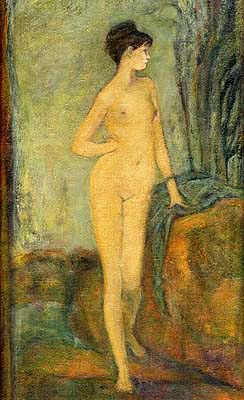 In addition to the renovations, Henry Young began collecting works of art and displaying them in his hotel, including the portrait of a young French girl named Marie. The painting, formerly known as, “Portrait of Chloe,” came to life in 1875 by Jules Joseph le Febvre in Paris. Some say that the girl was seduced by le Febvre at the age of 15 on one of his visits to the country, and later poisoned herself in front of him after her village found out about the painting. The painting was awarded the prestigious “Gold Medal of Honour,” at the Paris Salon shortly afterwards and was then displayed in the French Gallery at the Sydney International Exhibition in 1879 and at the Melbourne International Exhibition of 1880. There, Chloe was purchased by Dr Thomas Fitzgerald of Lonsdale Street, Melbourne, for 850 guineas. In 1883, Chloe was hung in the National Gallery of Victoria while Dr Fitzgerald visited Ireland for three years. The result was scandalous. The Sunday Observance League and the Presbyterian Assembly worked themselves up into a tizzy, and Chloe was withdrawn from the exhibition three weeks later and shipped off to the more liberal city of Adelaide to await Dr Fitzgerald’s return. In 1908, Dr Fitzgerald merged with the infinite and Chloe was purchased by Henry Young for €800. Chloe was then placed on permanent display in Young & Jackson’s Pub.
In addition to the renovations, Henry Young began collecting works of art and displaying them in his hotel, including the portrait of a young French girl named Marie. The painting, formerly known as, “Portrait of Chloe,” came to life in 1875 by Jules Joseph le Febvre in Paris. Some say that the girl was seduced by le Febvre at the age of 15 on one of his visits to the country, and later poisoned herself in front of him after her village found out about the painting. The painting was awarded the prestigious “Gold Medal of Honour,” at the Paris Salon shortly afterwards and was then displayed in the French Gallery at the Sydney International Exhibition in 1879 and at the Melbourne International Exhibition of 1880. There, Chloe was purchased by Dr Thomas Fitzgerald of Lonsdale Street, Melbourne, for 850 guineas. In 1883, Chloe was hung in the National Gallery of Victoria while Dr Fitzgerald visited Ireland for three years. The result was scandalous. The Sunday Observance League and the Presbyterian Assembly worked themselves up into a tizzy, and Chloe was withdrawn from the exhibition three weeks later and shipped off to the more liberal city of Adelaide to await Dr Fitzgerald’s return. In 1908, Dr Fitzgerald merged with the infinite and Chloe was purchased by Henry Young for €800. Chloe was then placed on permanent display in Young & Jackson’s Pub.
Since then Chloe has cast a spell on all that gaze upon her of the male gender. Adolescent boys have been known to steal glances of her whenever they could, and young soldiers off to the two World Wars, the Korean War and the Vietnam War would have a drink with her before being shipped out and on return visits. Letters were often written to her from the trenches from these soldiers swearing their true love and promising to return. Even today, veterans will drink in her company on ANZAC Day. So smitten was one American GI during World War II that, because he could not have her or steal her away, that he threw his glass of beer at her exclaiming that he, “would give her something to remember him by.” Chloe then underwent conservation in 1943, and was finally moved into her own salon, upstairs at Young & Jackson’s in 1987 when the pub was purchased by the Foster’s Brewing Group.
A Triumphant Return
In 1988, the National Trust and Heritage Victoria decreed that both Chloe and Young & Jackson’s remain bound together forever. Since then, they have been together except for a short stint when Chloe was placed on display at the National Gallery of Victoria during the pub’s much needed renovation in the late 1990s. “It ain’t new but it’s fresh,” was the slogan while Young & Jackson’s underwent an AUS $6 million renovation by its new owner, Carlton and United Breweries at that time. This renovation transformed the pub from a decaying bar reminiscent of how it began its life and described by Andrew Masterton as, “the grime-clad, flaking, faded yellow and green of Young & Jackson’s Pub,” into something worthy of the status, “Australia’s Most Famous Pub” and Victoria’s oldest hotel in continual operation. Instead of being, “merchandised into oblivion through T-shirts, postcards and crockery,” as Kevin D. Murray pointed out in 1995, Chloe has been tastefully redisplayed at Young & Jackson’s in a manner worthy of her celebrity status. Since 1909, Chloe has witnessed many things but, perhaps most importantly, the evolution of Australia from a distant colony into a great country. In that time, Chloe herself has won critical acclaim, has been used as the mascot for the HMAS Melbourne, and has become one of Melbourne’s most celebrated icons – in addition to being a fine work of art and the queen of Young & Jackson’s. All thanks to culture and class of Henry Young. For more information, visit the Young & Jackson’s Pub website. Cheers, ol’ Figsby!
